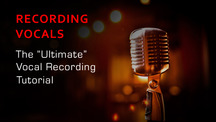Recording vocals often fills a beginner with a certain amount of trepidation. If it is your first time, it is a good idea to gather together as much information as possible in order to make the best possible job of it. The good news is that with some careful planning you should be able to make a completely professional sounding vocal recording the first time round. This vocal recording tutorial is going to help you achieve that goal.
Microphones
Fundamental to good vocal recordings are high quality microphones. Please leave the $15.00 plastic bodied microphones at the door when you come into the studio, and at the very least ensure you have a microphone suitable for project level studio work.
I suggest a good quality large diaphragm condenser mic or a high quality dynamic microphone. A condenser mic is sensitive, detailed, and often has a hi fi sound. You will require 48 volt phantom power on your microphone preamp in order to power the microphone. A condenser microphone will not work without this very specific powering method, so ensure your mixer or mic preamplifier can supply 48 volt phantom power.
Dynamic microphones are more robust and less sensitive, but offer a more rounded sound with less emphasis in the highs. They are often used on rock and hip hop vocals. You do not need 48 volt phantom power for this microphone type.
I will name a few low cost microphones to give you starting point. This is not specific endorsement for any given microphone but gives you an idea of where to start looking. These are all directional microphones which will usually be best suited for vocal work in domestic recording rooms.
- Rode NT1A – condenser, requires 48 volt phantom
- Audio Technica AT2020 – non-USB version, condenser requires 48 volt phantom
- sE Electronics SE2200a – condenser, requires 48 volt phantom
- Shure SM58 or SM57 – dynamic
I would suggest avoiding the temptation of buying a USB mic, unless you really have no other option. They may limit your recording choices in the future as you advance.
Every vocalist will sound different, and a choice must be made as to which microphone will suit the sonic goals best. We don't all have the luxury of a range of high end microphones, but if it is possible, best results are produced when a series of test recordings with different mics can be made for comparison.
Matching a microphone is about capturing and enriching desired vocal characteristics. This can take considerable time and if it is an option will produce the best end results assuming all other factors are in place.
Cables
A good quality microphone cable will retain all the detail and sonic information that comes from the microphone, so do not scrimp on the absolute cheapest cable you can find. It also shields the recording from external electromagnetic fields, clicks and hums.
If the cable needs to be long, high quality is even more important. I recommend a spend of £25.00/$45.00 on a 5 metre quality XLR male to XLR female cable.
Pop Shields and Wind Shields
These are not optional, they are essential. If you want to spend hours de-popping a great vocal take, that's up to you. But my advice is you should have a very good pop shield for any and all vocal recordings.
I have found that nylon mesh (similar to ladies tights) pop screens are superior to metal ones. I think this is because there are two layers of nylon with an air gap between around the "hoop". That's my own personal finding in practical use.
A condenser microphone with shock mount and pop shield inside an acoustic booth with acoustic panels on the background.
The foam wind shield often supplied with a microphone is least effective but does have its place with vocalists who are very "poppy". Pop intensity varies between vocalists, and it's best to be prepared for the worst. In a sentence, vocal pops are best dealt with at source and avoided from being recorded.
I tend to position the pop shield around 4-5 inches from the front of the microphone, and if required add the foam shield on the mic as well. I have also in the past attached two nylon pop shields to the stand. It is much easier to add a little "air" EQ if required than de-pop a vocal.
It is possible to angle the microphone off axis to the front of the mouth to reduce the likelihood of pops, although you must consider where the compromise between direct vocal vs. the lower likelihood of pops lies.
I cannot stress it enough—don't record pops, they will ruin an otherwise great recording.
Vocal Proximity and Positioning
I do not recommend distant mic techniques for beginners and/or for dynamic microphones when recording vocals, though this does depend to a degree on which microphone you are using.
The distance of the microphone from the mouth of the vocalist is important, and will relate to the perceived character of the recording. It needs to suit the music which it will be eventually mixed into.
Close – 2-4 inches
Being close to the microphone—a distance of 2-4 inches—will produce a close, breathy, warm claustrophobic, overly-detailed and tight vocal sound. You will hear every sound the mouth produces, including "lipsmacks", tiny clicks from the fluid in the mouth, and other sounds from the tongue and throat.
You are more likely to suffer from big vocal pops and sibilance (an emphasis of "esses" and "whistling sounds"), unless the vocal style is whispered.
Close vocal microphones also cause a proximity effect. This means there is a tendency for a natural lift in the low frequency response of the microphone.
Distant – 10-16 inches
Being distant from microphone—at around 10-16 inches—will produce a distant, roomier, less intense, natural, less bassy, open, less detailed, less direct, and less "in your face" vocal. It is also less likely to suffer from excessive sibilance.
Good Compromise – 6-10 inches
A typical working distance that produces decent results has been 6-10 inches, a good compromise distance. But ultimately you must choose which works best for the track. If in doubt try and position two mics at different distances, and record them both and see what works best.
The tone of a vocal can be changed dramatically by positioning the microphone off-axis from the mouth opening. You can experiment with the mic positions:
- Higher up near the nose can reduce pops and sibilance, but accentuate nasality.
- Lower down the microphone will record a deeper, less bright sound as the mic will pick up more deep resonances from the throat and chest cavity.
Make test recordings to hear the different effects on vocal tone.
Acoustic and Environmental Control
As a general rule vocal recordings benefit from a "dead" or acoustically neutral recording space. This allows greater flexibility in post-production such as the addition of reverb in different types and amounts.
A reflection and reverb-free recording is often preferred, as once any reverb from room reflections is recorded it is impossible to remove transparently. This fixes the character of the recording space, and if mistakes are made they are almost impossible to rectify.
You can add a reflection filter behind the microphone in order to reduce some of the energy making it to room boundaries. These are not a complete solution like a vocal recording booth.
You can help to minimize reflections by placing duvets/quilts on the walls in a room corner of the room and sing into the corner. Make a test recording to ensure the sound is not overly boxy as some of the lower frequency reflections can build up at high singing intensities. Singing into a large corner bass trap would be very effective at reducing room reflections if the room is fairly well damped in general.
Also, consider extraneous room noises such as ticking clocks, radiators, heating and cooling, creaks, computer fan noises, etc. Try and work out what noises you have and stop them at source. If you use a directional microphone, angle it so that any of these extraneous noises are nulled in the microphone's polar response.
Recording Levels
One of the worst possible vocal recording problems is distortion. Once it is there is it almost impossible to remove, and it is to be avoided completely. It is also very easy for the human ear to hear. Our ears are highly sensitive to any changes in the human voice.
In all recording work, gain structure is very important. It relates to minimizing the inherent noise floor of equipment and systems, and the avoidance of distortion either in analogue or digital domains.
When recording vocals, always record at 24-bit resolution, and I suggest a peak record level of -10 dBFS. At 24-bit there is no need to push the level higher than this.
These settings should produce the best signal-to-noise ratio with the vast majority of microphone pre-amplifiers. In any event, avoid any red lights on microphone pre-amps or mixing console channels when recording.
It is prudent to peak the vocal to -12 dBFS when taking recording levels, as the vocalist will often sing more intensely when an actual recording take happens.
Dynamic Range Control During Recording
Some engineers like to add some gentle analogue compression during the recording phase. This can be done for artistic or technical control reasons. For example, a nice valve compressor can add character.
For character purposes this is fine, but may not be necessary as long as you ensure that you have ample headroom in your microphone preamplifier and recording interface.
If you have a vocalist with large dynamic swings (from quiet to loud), it may be a good idea to apply 2-3 dB of gain reduction on the peaks of the vocals during the recording stage.
Do be careful not to over compress the vocal when you are starting out, because once you have recorded the compression it will be very difficult to adjust the effects of the time constants on the recording. If in doubt, leave more headroom (record at a lower level), and do not compress when recording.
I tend to use an attack of 10-20 ms, and a release of between 150 and 200 ms for a vocal recording, and keep the gain reduction fairly light, around 3 dB maximum.
Environment
The performance you get from the vocalist will relate to their comfort and confidence. As such make sure the room temperature is comfortable—not too hot and not too cold. Room temperature water should be available at all times.
If the vocalist has an inspiring object that is important to them, let them bring it into the studio and place it in front of them while they sing. This could be a photo or an object. It can bring a sense of inspiration and emotion, which is what most vocalists are trying to convey.
You will want to have a good chair available if the vocalist wishes to sit, although most wish to stand as the respiratory system is more open and vital when standing.
Some vocalist prefer to sing away from the glass, or facing away from the engineer. Make this completely ok and natural. The more comfortable the vocalist the better the performance you will capture.
As a recorder and engineer, your job is to make the vocalist as comfortable and relaxed as possible. This means nailing the engineering side so it is transparent.
I suggest testing all the equipment before the vocalist arrives in the studio. Make test recordings, and check that the headphones and talk back systems are working effectively. Also check any monitoring sends are working and set up correctly. Reverb in the cans is a common request.
Headphone Mixes
Most vocal recordings are done with headphone monitoring, so it is important that this headphone feed is as clear and articulate as possible. Make sure you can be heard, and that the levels provided are optimal for the vocalist. It is a very important factor in how the vocal will be delivered, both technically and in mood, so do everything possible to ensure an excellent headphone monitoring situation.
Before the session, check with the vocalist about what kind of monitoring arrangements they perform best to. Some may like a small PA monitor speaker in the studio, or may be bringing their own "in-ear monitoring" system.
Microphone Preamplifiers
A vocal recording tutorial would not be complete without mention of microphone pre-amplifiers. Some of these are very low-cost, such as those found in a standard mixing console, and some can cost thousands of dollars. They can definitely affect the clarity and tone of the recording.
Some are designed with absolute fidelity and accuracy in mind, and some are designed with classic circuits, valves and transformers to add some vintage character to a recording. This is very subjective and you must determine if a preamplifier will add something special to a recording or not.
All of the above is essential, but a microphone preamplifier at least should be very low noise, and represent the output of the microphone in an articulate manner.
As you progress in your recording skill, you will be better equipped to hear the subtle differences between the myriad pre-amplifiers on the music technology market.
Summary
It is completely possible to record a stunning vocal recording with your first-ever recording if you follow these guidelines. It is not particularly difficult if you have the right equipment and make good preparations before the task commences.
Most of the above procedures can be run through using your own voice as a guide. Setting up well and preparing in advance will make the session run more smoothly.












